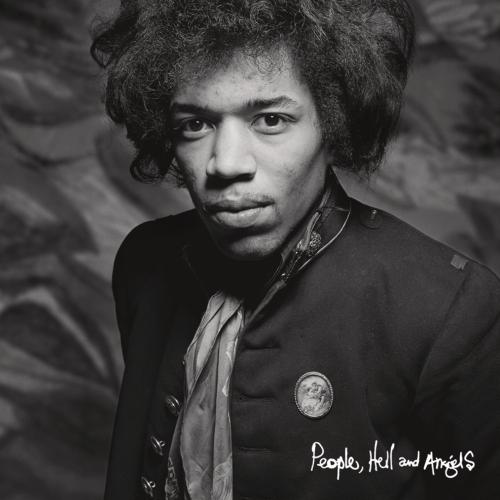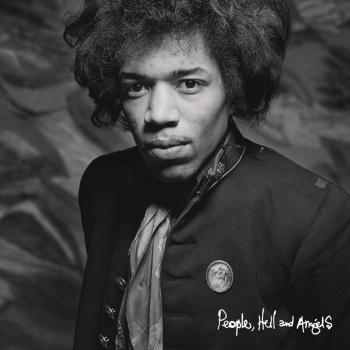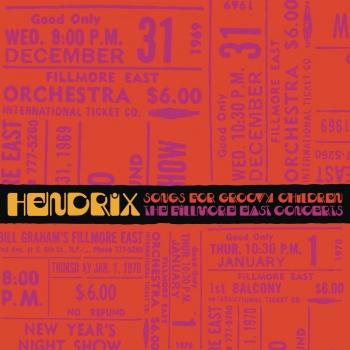
People, Hell & Angels (Remastered) Jimi Hendrix
Album info
Album-Release:
2013
HRA-Release:
01.02.2018
Album including Album cover
I`m sorry!
Dear HIGHRESAUDIO Visitor,
due to territorial constraints and also different releases dates in each country you currently can`t purchase this album. We are updating our release dates twice a week. So, please feel free to check from time-to-time, if the album is available for your country.
We suggest, that you bookmark the album and use our Short List function.
Thank you for your understanding and patience.
Yours sincerely, HIGHRESAUDIO
- 1 Earth Blues 03:34
- 2 Somewhere 04:06
- 3 Hear My Train a Comin' 05:42
- 4 Bleeding Heart 03:58
- 5 Let Me Move You 06:50
- 6 Izabella 03:43
- 7 Easy Blues 05:57
- 8 Crash Landing 04:15
- 9 Inside Out 05:04
- 10 Hey Gypsy Boy 03:39
- 11 Mojo Man 04:07
- 12 Villanova Junction Blues 01:48
Info for People, Hell & Angels (Remastered)
People, Hell & Angels, is an essential new album premiering twelve previously unreleased studio recordings completed by guitarist Jimi Hendrix. People, Hell & Angels, showcases the legendary guitarist working outside of the original Jimi Hendrix Experience trio. Beginning in 1968, Jimi Hendrix grew restless, eager to develop new material with old friends and new ensembles. Outside the view of a massive audience that had established the Experience as rock’s largest grossing concert act and simultaneously placed two of his albums in the US Top 10 sales chart, Jimi was busy working behind the scenes to craft his next musical statement.
These twelve recordings encompass a variety of unique sounds and styles incorporating many of the elements—horns, keyboards, percussion and second guitar—Jimi wanted to incorporate within his new music. People, Hell & Angels, presents some of the finest Jimi Hendrix guitar work ever issued and provides a compelling window into his growth as a songwriter, musician and producer.
People, Hell & Angels, will be available Tuesday, March 5, 2013.
With an album title coined by Jimi Hendrix, People, Hell & Angels, reveals some of Hendrix’s post-Experience ambitions and directions as he worked with new musicians–including the Buffalo Springfield’s Stephen Stills, drummer Buddy Miles, Billy Cox (with whom Hendrix had served in the 101st US Army Airborne and later played on the famed R & B ‘chitlin circuit’ together) and others–creating fresh and exciting sounds for the next chapter in his extraordinary career.
People, Hell & Angels, is co-produced by Janie Hendrix, Eddie Kramer and John McDermott. Kramer first met Hendrix at Olympic Studios in London in January 1967. Hendrix, who would have turned 70 on November 27 this year, developed a unique rapport with Kramer. As a result, Kramer engineered every album issued by the guitarist in his lifetime and recorded such famous Hendrix concerts as the Woodstock festival in August 1969. Since 1997, Kramer has teamed with
Janie Hendrix and John McDermott to oversee the release of each Jimi Hendrix album issued by Experience Hendrix.
The dozen previously unreleased Jimi Hendrix performances premiering on People, Hell & Angels, include “Earth Blues,” “Somewhere,” “Hear My Train A Comin’,” “Bleeding Heart,” “Baby Let Me Move You,” “Izabella,” “Easy Blues,” “Crash Landing,” “Inside Out,” “Hey Gypsy Boy,” “Mojo Man” and “Villanova Junction Blues.”
A musical companion piece and successor to 2010’s Valleys Of Neptune, the critically acclaimed album showcasing the artist’s final recordings with the original Jimi Hendrix Experience, People, Hell & Angels, offers tantalizing new clues as to the direction Hendrix was considering for First Rays Of The New Rising Sun, his planned double album sequel to 1968’s groundbreaking Electric Ladyland.
Unlike contemporaries such as the Beatles or Bob Dylan, Jimi Hendrix owned his songs and master recordings. He did not have to record his music at recording studios owned and operated by his record company. Hendrix spent countless hours recording his new music at new, independent music studios such as New York’s Record Plant and the Hit Factory. Hendrix was so focused on recording his music that, concurrent with nearly all of the sessions featured as part of People, Hell & Angels,, he was underwriting the construction of his own recording facility–the state of the art Electric Lady Studios in Greenwich Village.
Janie L. Hendrix, President/CEO of Experience Hendrix LLC, commented, “We’re thrilled to be able to release People, Hell & Angels, during the celebration of the 70th anniversary of my brother’s birth. The brilliance of the album serves to underscore what we’ve known all along: that there has never been and never will be a musical force equal to his and that we cherish and take inspiration of what he left us both now and for many generations to come…simply eternity.”
People, Hell & Angels, provides us with further insight into the genius of Jimi Hendrix,” said Adam Block, President, Legacy Recordings. “Working with new rhythm sections and instrumentation, Jimi Hendrix was opening up the horizons of his music, creating new sounds filled with endless possibilities.”
Recorded March 1968 – August 1970 at Record Plant, Hit Factory, Sound Centre, Electric Lady; New York City; Fame, Muscle Shoals, Alabama
Produced by Jimi Hendrix, Eddie Kramer, Janie Hendrix, John McDermott
Digitally remastered
Jimi Hendrix
Widely recognized as one of the most creative and influential musicians of the 20th century, Jimi Hendrix pioneered the explosive possibilities of the electric guitar. Hendrix's innovative style of combining fuzz, feedback and controlled distortion created a new musical form. Because he was unable to read or write music, it is nothing short of remarkable that Jimi Hendrix's meteoric rise in the music took place in just four short years. His musical language continues to influence a host of modern musicians, from George Clinton to Miles Davis, and Steve Vai to Jonny Lang.
Jimi Hendrix, born Johnny Allen Hendrix at 10:15 a.m. on November 27, 1942, at Seattle's King County Hospital, was later renamed James Marshall by his father, James 'Al' Hendrix. Young Jimmy (as he was referred to at the time) took an interest in music, drawing influence from virtually every major artist at the time, including B.B. King, Muddy Waters, Howlin' Wolf, Buddy Holly, and Robert Johnson. Entirely self-taught, Jimmy's inability to read music made him concentrate even harder on the music he heard.
Al took notice of Jimmy's interest in the guitar, recalling, 'I used to have Jimmy clean up the bedroom all the time while I was gone, and when I would come home I would find a lot of broom straws around the foot of the bed. I'd say to him, `Well didn't you sweep up the floor?' and he'd say, `Oh yeah,' he did. But I'd find out later that he used to be sitting at the end of the bed there and strumming the broom like he was playing a guitar.' Al found an old one-string ukulele, which he gave to Jimmy to play a huge improvement over the broom.
By the summer of 1958, Al had purchased Jimmy a five-dollar, second-hand acoustic guitar from one of his friends. Shortly thereafter, Jimmy joined his first band, The Velvetones. After a three-month stint with the group, Jimmy left to pursue his own interests. The following summer, Al purchased Jimmy his first electric guitar, a Supro Ozark 1560S; Jimi used it when he joined The Rocking Kings.
In 1961, Jimmy left home to enlist in the United States Army and in November 1962 earned the right to wear the 'Screaming Eagles' patch for the paratroop division. While stationed at Fort Campbell, Kentucky, Jimmy formed The King Casuals with bassist Billy Cox. After being discharged due to an injury he received during a parachute jump, Jimmy began working as a session guitarist under the name Jimmy James. By the end of 1965, Jimmy had played with several marquee acts, including Ike and Tina Turner, Sam Cooke, the Isley Brothers, and Little Richard. Jimmy parted ways with Little Richard to form his own band, Jimmy James and the Blue Flames, shedding the role of back-line guitarist for the spotlight of lead guitar.
Throughout the latter half of 1965, and into the first part of 1966, Jimmy played the rounds of smaller venues throughout Greenwich Village, catching up with Animals' bassist Chas Chandler during a July performance at Cafe Wha? Chandler was impressed with Jimmy's performance and returned again in September 1966 to sign Hendrix to an agreement that would have him move to London to form a new band.
Switching gears from bass player to manager, Chandler's first task was to change Hendrix's name to 'Jimi.' Featuring drummer Mitch Mitchell and bassist Noel Redding, the newly formed Jimi Hendrix Experience quickly became the talk of London in the fall of 1966.
The Experience's first single, 'Hey Joe,' spent ten weeks on the UK charts, topping out at spot No. 6 in early 1967. The debut single was quickly followed by the release of a full-length album Are You Experienced, a psychedelic musical compilation featuring anthems of a generation. Are You Experienced has remained one of the most popular rock albums of all time, featuring tracks like 'Purple Haze,' 'The Wind Cries Mary,' 'Foxey Lady,' 'Fire,' and 'Are You Experienced?'
Although Hendrix experienced overwhelming success in Britain, it wasn't until he returned to America in June 1967 that he ignited the crowd at the Monterey International Pop Festival with his incendiary performance of 'Wild Thing.' Literally overnight, The Jimi Hendrix Experience became one of most popular and highest grossing touring acts in the world.
Hendrix followed Are You Experienced with Axis: Bold As Love. By 1968, Hendrix had taken greater control over the direction of his music; he spent considerable time working the consoles in the studio, with each turn of a knob or flick of the switch bringing clarity to his vision.
Back in America, Jimi Hendrix built his own recording studio, Electric Lady Studios in New York City. The name of this project became the basis for his most demanding musical release, a two LP collection, Electric Ladyland. Throughout 1968, the demands of touring and studio work took its toll on the group and in 1969 the Experience disbanded.
The summer of 1969 brought emotional and musical growth to Jimi Hendrix. In playing the Woodstock Music & Art Fair in August 1969, Jimi joined forces with an eclectic ensemble called Gypsy Sun & Rainbows featuring Jimi Hendrix, Mitch Mitchell, Billy Cox, Juma Sultan, and Jerry Velez. The Woodstock performance was highlighted by the renegade version of 'Star Spangled Banner,' which brought the mud-soaked audience to a frenzy.
Nineteen sixty-nine also brought about a new and defining collaboration featuring Jimi Hendrix on guitar, bassist Billy Cox and Electric Flag drummer Buddy Miles. Performing as the Band of Gypsys, this trio launched a series of four New Year's performances on December 31, 1969 and January 1, 1970. Highlights from these performances were compiled and later released on the quintessential Band of Gypsys album in mid-1970 and the expanded Hendrix: Live At The Fillmore East in 1999.
As 1970 progressed, Jimi brought back drummer Mitch Mitchell to the group and together with Billy Cox on bass, this new trio once again formed The Jimi Hendrix Experience. In the studio, the group recorded several tracks for another two LP set, tentatively titled First Rays Of The New Rising Sun. Unfortunately, Hendrix was unable to see this musical vision through to completion due to his hectic worldwide touring schedules, then tragic death on September 18, 1970. Fortunately, the recordings Hendrix slated for release on the album were finally issued through the support of his family and original studio engineer Eddie Kramer on the 1997 release First Rays Of The New Rising Sun.
From demo recordings to finished masters, Jimi Hendrix generated an amazing collection of songs over the course of his short career. The music of Jimi Hendrix embraced the influences of blues, ballads, rock, R&B, and jazz a collection of styles that continue to make Hendrix one of the most popular figures in the history of rock music. (Source: Sony)
This album contains no booklet.











